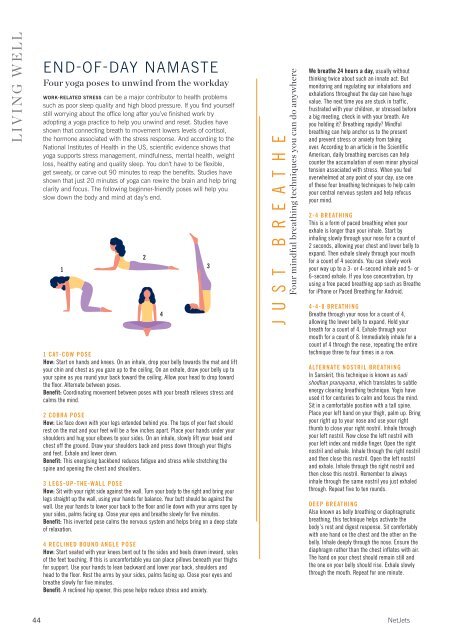Create successful ePaper yourself
Turn your PDF publications into a flip-book with our unique Google optimized e-Paper software.
LIVING WELL<br />
END-OF-DAY NAMASTE<br />
Four yoga poses to unwind from the workday<br />
WORK-RELATED STRESS can be a major contributor to health problems<br />
such as poor sleep quality and high blood pressure. If you find yourself<br />
still worrying about the office long after you’ve finished work try<br />
adopting a yoga practice to help you unwind and reset. Studies have<br />
shown that connecting breath to movement lowers levels of cortisol,<br />
the hormone associated with the stress response. And according to the<br />
National Institutes of Health in the US, scientific evidence shows that<br />
yoga supports stress management, mindfulness, mental health, weight<br />
loss, healthy eating and quality sleep. You don’t have to be flexible,<br />
get sweaty, or carve out 90 minutes to reap the benefits. Studies have<br />
shown that just 20 minutes of yoga can rewire the brain and help bring<br />
clarity and focus. The following beginner-friendly poses will help you<br />
slow down the body and mind at day’s end.<br />
1<br />
1 CAT-COW POSE<br />
How: Start on hands and knees. On an inhale, drop your belly towards the mat and lift<br />
your chin and chest as you gaze up to the ceiling. On an exhale, draw your belly up to<br />
your spine as you round your back toward the ceiling. Allow your head to drop toward<br />
the floor. Alternate between poses.<br />
Benefit: Coordinating movement between poses with your breath relieves stress and<br />
calms the mind.<br />
2 COBRA POSE<br />
How: Lie face down with your legs extended behind you. The tops of your feet should<br />
rest on the mat and your feet will be a few inches apart. Place your hands under your<br />
shoulders and hug your elbows to your sides. On an inhale, slowly lift your head and<br />
chest off the ground. Draw your shoulders back and press down through your thighs<br />
and feet. Exhale and lower down.<br />
Benefit: This energising backbend reduces fatigue and stress while stretching the<br />
spine and opening the chest and shoulders.<br />
3 LEGS-UP-THE-WALL POSE<br />
How: Sit with your right side against the wall. Turn your body to the right and bring your<br />
legs straight up the wall, using your hands for balance. Your butt should be against the<br />
wall. Use your hands to lower your back to the floor and lie down with your arms open by<br />
your sides, palms facing up. Close your eyes and breathe slowly for five minutes.<br />
Benefit: This inverted pose calms the nervous system and helps bring on a deep state<br />
of relaxation.<br />
4 RECLINED BOUND ANGLE POSE<br />
How: Start seated with your knees bent out to the sides and heels drawn inward, soles<br />
of the feet touching. If this is uncomfortable you can place pillows beneath your thighs<br />
for support. Use your hands to lean backward and lower your back, shoulders and<br />
head to the floor. Rest the arms by your sides, palms facing up. Close your eyes and<br />
breathe slowly for five minutes.<br />
Benefit: A reclined hip opener, this pose helps reduce stress and anxiety.<br />
2<br />
4<br />
3<br />
J U S T B R E A T H E<br />
Four mindful breathing techniques you can do anywhere<br />
We breathe 24 hours a day, usually without<br />
thinking twice about such an innate act. But<br />
monitoring and regulating our inhalations and<br />
exhalations throughout the day can have huge<br />
value. The next time you are stuck in traffic,<br />
frustrated with your children, or stressed before<br />
a big meeting, check in with your breath. Are<br />
you holding it? Breathing rapidly? Mindful<br />
breathing can help anchor us to the present<br />
and prevent stress or anxiety from taking<br />
over. According to an article in the Scientific<br />
American, daily breathing exercises can help<br />
counter the accumulation of even minor physical<br />
tension associated with stress. When you feel<br />
overwhelmed at any point of your day, use one<br />
of these four breathing techniques to help calm<br />
your central nervous system and help refocus<br />
your mind.<br />
2-4 BREATHING<br />
This is a form of paced breathing when your<br />
exhale is longer than your inhale. Start by<br />
inhaling slowly through your nose for a count of<br />
2 seconds, allowing your chest and lower belly to<br />
expand. Then exhale slowly through your mouth<br />
for a count of 4 seconds. You can slowly work<br />
your way up to a 3- or 4-second inhale and 5- or<br />
6-second exhale. If you lose concentration, try<br />
using a free paced breathing app such as Breathe<br />
for iPhone or Paced Breathing for Android.<br />
4-4-8 BREATHING<br />
Breathe through your nose for a count of 4,<br />
allowing the lower belly to expand. Hold your<br />
breath for a count of 4. Exhale through your<br />
mouth for a count of 8. Immediately inhale for a<br />
count of 4 through the nose, repeating the entire<br />
technique three to four times in a row.<br />
ALTERNATE NOSTRIL BREATHING<br />
In Sanskrit, this technique is known as nadi<br />
shodhan pranayama, which translates to subtle<br />
energy clearing breathing technique. Yogis have<br />
used it for centuries to calm and focus the mind.<br />
Sit in a comfortable position with a tall spine.<br />
Place your left hand on your thigh, palm up. Bring<br />
your right up to your nose and use your right<br />
thumb to close your right nostril. Inhale through<br />
your left nostril. Now close the left nostril with<br />
your left index and middle finger. Open the right<br />
nostril and exhale. Inhale through the right nostril<br />
and then close this nostril. Open the left nostril<br />
and exhale. Inhale through the right nostril and<br />
then close this nostril. Remember to always<br />
inhale through the same nostril you just exhaled<br />
through. Repeat five to ten rounds.<br />
DEEP BREATHING<br />
Also known as belly breathing or diaphragmatic<br />
breathing, this technique helps activate the<br />
body’s rest and digest response. Sit comfortably<br />
with one hand on the chest and the other on the<br />
belly. Inhale deeply through the nose. Ensure the<br />
diaphragm rather than the chest inflates with air.<br />
The hand on your chest should remain still and<br />
the one on your belly should rise. Exhale slowly<br />
through the mouth. Repeat for one minute.<br />
44 NetJets


















